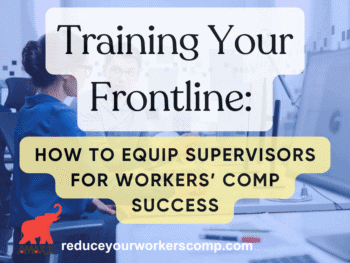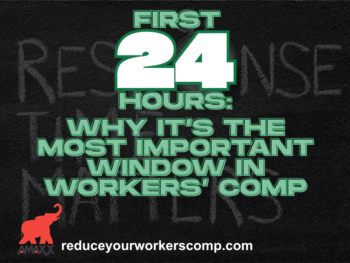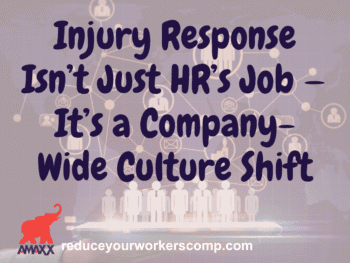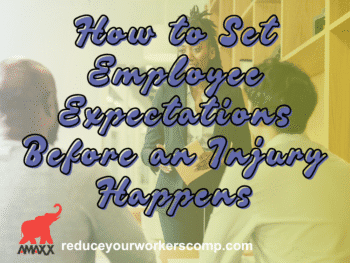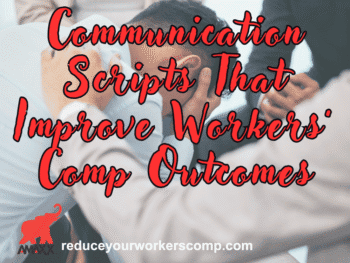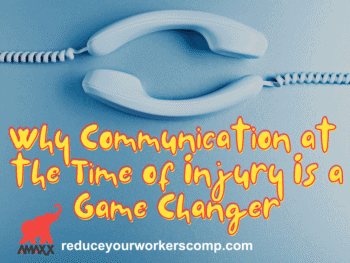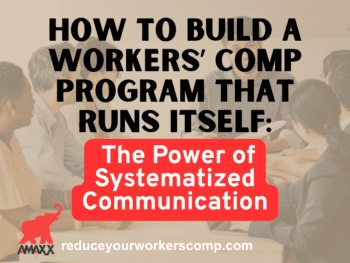One of the things I find most interesting about workers’ compensation is that at its core, it’s incredibly simple. But as you go further beyond that, it becomes more and more and more complex to the point that it becomes overwhelming.
Hello. My name is Michael Stack. I’m the CEO of AMAXX, and today I want to outline for you the four pillars of our best in class injury management system. But I don’t want to get into any of the complexity that may come long with return to work and injury response, procedure and system as well as working with your claims handler and your carrier or your TPA, your vendors or your medical providers.
I want to talk about one element, which is communication, which at its core is the simplest aspect of workers’ compensation management. If you do this piece well, it’s the blanket that’s going to lay over the entire system, and you’re at last 50% if not 75% of the way there towards producing those better outcomes for your injured workers and dramatically reducing your work comp costs. Let’s talk about these most simple elements of communication that can have the most dramatic results.
Proactive & Reactive Communication
There’s two aspects of communication. There’s proactive communication, and there’s reactive. Proactive, of course, the elements that occur before an injury happens. Reactive is those elements that occur after an injury happens. There’s a few different things that go into proactive communication including setting your policies, setting up elements with your medical providers, but the one that has the most dramatic impact on your employees is extremely simple to set up and will deliver those dramatic results is a simple employee brochure.
If you think about majority of your employees, they’ve never been injured before. They’ve never had an experience of workers’ compensation, and it can seem overwhelming to them. Put in your employee brochure these couple of different elements. What is work comp? Why does it exist, and what are the basics of what happens? We deal with this stuff every day, and most employees have never been inured before, so what is it.
Set Expectations with Employee Brochure
Set their expectations as far as what’s gonna happen. Let them know that you’re expected to return to work. Our policy is that we’re gonna accommodate the vast majority of injuries, so you’re expected to return to work. And we expect your cooperation in that as part of our team. We care about you, and we want you back to work. We want you to continue to be productive for yourself and for our organization.
Lastly, let them know how they’re gonna get their medical treatment. Are they able to choose their own doctor? Let them know that they don’t have to pay for a deductible. Do you choose the doctor for them? What is some basic information that you can provide to your employees prior to being injured? One of the elements that WCRI noted in this study was that the number one reason why employees hired attorneys is a fear of getting fired. If you let them know that you care about your employees, you want them back to work, this is how you get your treatment, we’re gonna take care of you, that odds of them hiring an attorney and that claim going off the track become significantly lower. Very simple element. Create employee brochure, disseminate it to your employees prior to injury.
Let’s talk about after an injury occurs. You set this expectation now with your employee brochure, now all you have to do is meet that expectation. You have to demonstrate that care to your employees. Get them to that medical treatment as soon as possible. If you let them know you care about them, they’re more likely to report the claim right away, more likely to get to that medical provider right away, more likely to get those medical restrictions right away to put them right into your return to work program.
Make Communication Simple & Effective
This care is demonstrated through a few different elements. One is letting them know and reminding them what to do at time of injury. You have a wallet card. You have posters. You have some different communication pieces around the organization, around your office that says what to do. Here’s steps one, two, three, four, five, six, and seven. Maybe it’s also hanging on their lanyard. Something that demonstrates what to do at time of injury.
The next piece here is a get well card/a call/a visit. There’s a lot of advancements in our world today, a lot of automation, a lot of predictive analytics, a lot of information that comes from big data. Taking three minutes to have the supervisor write and sign a get well card–hey Tom, we care about you, we’re sorry you got injured, we can’t wait to have you back–will have more impact than all of the big data in the world on John’s emotions, on John’s motivation to return back to your company in a return to work program. You give that person a call. You let them now, hey, how are you doing, how’s everything going. You can assess that person’s attitude, you can demonstrate care, and you can get incredible claims management information, if they’re attitude is poor, if they’re very frustrated, if they’re having a lot of challenges with their medical providers. You can get on top of that right away by giving that person a call or going to visit them at the hospital.
Workers’ compensation is an incredibly complex system, but at its core, it’s incredibly simple. Follow these best practices of communication in order to start you on the path of realizing those dramatic results.
Again, I’m Michael Stacks, CEO of AMAXX, and remember your work today in workers’ compensation can have a dramatic impact on your company’s bottom line, but it will have a dramatic impact on someone’s life. So, be great.

Contact: mstack@reduceyourworkerscomp.com.
Workers’ Comp Roundup Blog: https://blog.reduceyourworkerscomp.com/
©2017 Amaxx LLC. All rights reserved under International Copyright Law.
Do not use this information without independent verification. All state laws vary. You should consult with your insurance broker, attorney, or qualified professional.





